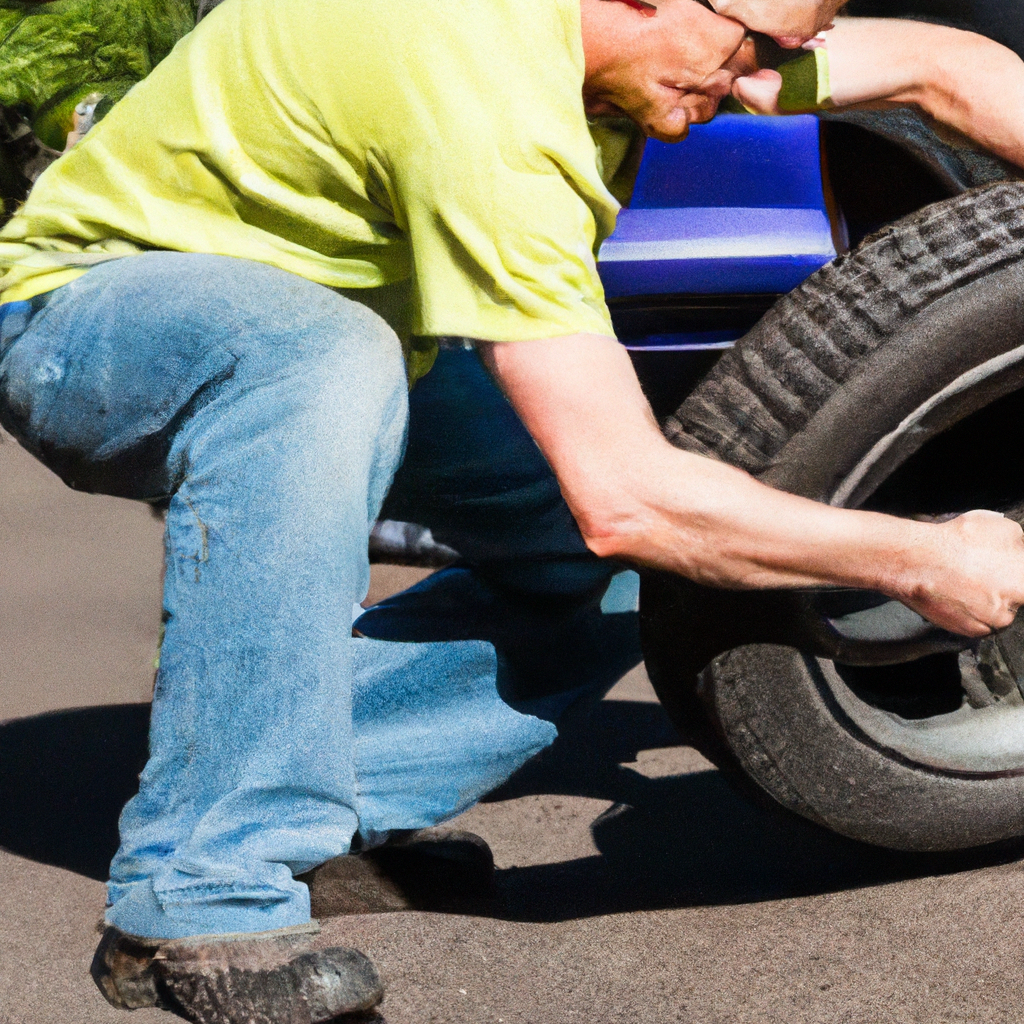Changing your car tires is a necessary task that may seem simple, but it requires caution and proper execution to ensure your safety. In this article, we will explore the essential precautions you should take when performing tire changes. From properly securing your vehicle to using the appropriate tools, we will guide you through the steps to ensure a smooth and accident-free tire change. So, grab your toolbox and let’s get started on making your tire changes stress-free and safe!

Choosing the Right Safety Gear
When it comes to any automotive maintenance task, safety should always be a top priority. Before you even begin changing a tire, make sure you are equipped with the right safety gear. Protective clothing, safety glasses, and gloves are essential items that will help keep you safe throughout the process.
Wearing Protective Clothing
Before you start changing a tire, it’s important to wear the right protective clothing. Make sure you are dressed in long pants and a long-sleeved shirt to protect your skin from any potential hazards. Avoid loose-fitting clothing that could get caught in moving parts. Additionally, wearing closed-toe shoes with good traction will help prevent slips and falls.
Using Safety Glasses
When changing a tire, there is a risk of dirt, debris, and even small metal parts getting into your eyes. To protect your vision, it is crucial to wear safety glasses while performing this task. Safety glasses will shield your eyes from any potential flying objects and ensure that you can continue to work safely and effectively.
Using Gloves
Handling tires, wheels, and tools can expose your hands to sharp edges, rough surfaces, and potentially harmful chemicals. To protect your hands from cuts, bruises, and exposure to contaminants, wearing gloves is essential. Choose gloves that fit properly and provide excellent grip to ensure you can handle tools and equipment with precision and safety.
Ensuring a Safe Work Environment
Creating a safe work environment is equally important as wearing the right safety gear. When working on a tire change, there are several precautions you can take to ensure a safe workspace.
Working on a Flat Surface
Before starting any tire change, make sure your vehicle is parked on a flat surface. This will provide stability and prevent the vehicle from rolling or shifting while you are working underneath it. Avoid working on uneven terrain or slopes to maintain a safe work environment.
Using Wheel Chocks
To further prevent any unintended movement of the vehicle, it is advisable to use wheel chocks. Wheel chocks are wedge-shaped blocks that can be placed against the tires to prevent them from rolling. By strategically positioning these chocks, you can provide an extra layer of safety and peace of mind while working on your tire change.
Working in a Well-lit Area
Proper visibility is crucial for any automotive task, including tire changes. Make sure you are working in a well-lit area to clearly see what you are doing. Natural daylight or a bright artificial light source will help you inspect the tire, wheel, and tools more effectively. Adequate lighting will also minimize the possibility of accidents caused by poor visibility.
Preparing the Vehicle
Before lifting the vehicle, there are a few steps you should follow to ensure it is properly prepared for the tire change.
Parking the Vehicle
First and foremost, park your vehicle on a stable surface away from traffic. Choose a location that provides enough space for you to safely work around the vehicle. If you are on the side of the road, make sure your hazard lights are on to alert other drivers.
Engaging the Parking Brake
Engaging the parking brake helps prevent any movement of the vehicle and adds an extra layer of safety during tire changes. Before lifting the vehicle, make sure to engage the parking brake fully, ensuring the vehicle remains stationary throughout the process.
Loosening the Lug Nuts
Next, you will need to loosen the lug nuts before lifting the vehicle. Use a lug wrench or a suitable socket wrench to loosen the lug nuts slightly. This step is crucial because it is much easier to loosen the lug nuts when the weight of the vehicle is still on the tires. So, make sure to loosen them just enough to rotate them counterclockwise, but do not remove them completely at this stage.
Lift the Vehicle Safely
Now that you have prepared the vehicle, it’s time to safely lift it off the ground. Follow these steps to ensure a secure and stable lifting process.
Using a Hydraulic Jack or Car Lift
To lift the vehicle, you have two main options: a hydraulic jack or a car lift. A hydraulic jack is a common tool used for tire changes, and it offers portability and ease of use. Ensure you position the jack correctly under the designated jack points, which are typically indicated in the vehicle’s owner manual.
Checking the Jack Points
Before lifting the vehicle, it’s important to locate and inspect the jack points. These are specific areas on the vehicle’s chassis designed to support the weight of the vehicle when lifted. Consult your owner’s manual to identify the proper jack points for your vehicle, as using incorrect points can lead to damage or instability.
Placing Jack Stands
While a hydraulic jack can lift the vehicle, it is not designed to hold it in place for an extended period. To ensure the safety of both you and the vehicle, it is crucial to place jack stands under the vehicle’s chassis once it has been lifted. Jack stands provide a stable base of support, preventing any accidental collapses or shifts while you are working on the tire change.

Removing the Wheel
With the vehicle safely lifted, it’s time to remove the old wheel. Follow these steps to safely and efficiently remove the wheel.
Using a Lug Wrench
To remove the lug nuts, you will need to use a lug wrench. Position the lug wrench securely over the lug nuts and rotate them counterclockwise to loosen them further. Remember to turn the wrench in the appropriate direction, as attempting to turn the lug nuts the wrong way can lead to frustration and potential damage.
Loosening and Removing the Lug Nuts
Once the lug nuts are sufficiently loosened, you can remove them completely. Place them in a safe location nearby, making sure not to misplace or lose them. It is also a good idea to keep them organized in the order they were removed, as this can help during the reinstallation process later.
Taking Off the Wheel
With the lug nuts removed, it is time to take off the old wheel. Carefully grip the wheel with both hands and gently pull it towards you. If the wheel feels stuck, you can gently kick it with the heel of your shoe or use a rubber mallet to loosen it. Always be cautious of your posture and use proper lifting techniques to avoid any unnecessary strain or injury.
Inspecting the Tire and Wheel
Once the old wheel is removed, it is crucial to inspect both the tire and the wheel before installing the new one. These inspections will help ensure the safety and longevity of your new tire.
Checking the Tire Tread
Inspect the tire tread for any signs of wear or damage. Look for uneven wear patterns, bulges, or cuts in the tread. A worn or damaged tire can compromise your safety on the road, so it’s important to replace any tires that show signs of excessive wear or damage.
Inspecting for Any Damage
Examine the wheel for any cracks, bends, or other visible damage. A damaged wheel can affect tire performance and compromise safety. If you notice any significant damage, it is advisable to replace the wheel or seek professional assistance.
Cleaning the Wheel
Before installing the new tire, take the opportunity to clean the wheel thoroughly. Remove any dirt, debris, or brake dust using a specialized wheel cleaner and a soft brush or sponge. A clean wheel not only looks better but also creates a better seal between the tire and the wheel, ensuring optimal performance.

Installing the New Tire
With the inspections complete, it’s time to install the new tire onto the wheel. Follow these steps to ensure a proper and secure installation.
Aligning the Wheel with the Hub
Before mounting the new tire, it’s crucial to align the wheel with the hub. This involves carefully positioning the wheel so that the holes on the wheel align perfectly with the studs on the wheel hub. Take your time during this step to ensure a precise fit and prevent any issues later on.
Mounting the Tire on the Wheel
With the wheel properly aligned, it’s time to mount the new tire. Start by placing the tire onto the wheel, making sure the tire bead is seated evenly around the rim. Use a tire iron or a similar tool to gradually work the tire onto the wheel, using an organized and steady motion. Take care not to damage the tire or the wheel during this process.
Tightening the Lug Nuts
Once the tire is mounted on the wheel, it’s time to secure it using the lug nuts. Start by hand-tightening each lug nut to its corresponding stud. Then, using a lug wrench, tighten the lug nuts in a star or crisscross pattern. This ensures an even distribution of torque, promoting stability and preventing any wheel wobbling. Finally, use a torque wrench to achieve the manufacturer-recommended tightening torque for your specific vehicle.
Lowering the Vehicle
With the new tire properly installed, it’s time to lower the vehicle back to the ground. Follow these steps to ensure a safe and controlled descent.
Removing Jack Stands and Lowering the Vehicle
Before lowering the vehicle, it’s important to remove the jack stands first. Carefully position yourself under the vehicle, ensuring you have a clear path to the jack stands. Slowly and steadily lower the vehicle using the hydraulic jack, making sure the vehicle is descending evenly and smoothly. Once the vehicle is safely on the ground, remove the jack stands from their positions.
Torquing the Lug Nuts
After lowering the vehicle, it’s time to torque the lug nuts to the appropriate specification. Using a torque wrench, tighten each lug nut in a star or crisscross pattern, following the manufacturer’s recommended torque setting. Properly torqued lug nuts ensure a secure connection between the wheel and the vehicle, reducing the risk of the wheel loosening or coming off while driving.
Double-checking Wheel Alignment
Once all the lug nuts are torqued to the proper specification, it’s a good idea to double-check the wheel alignment. Stand back and visually inspect the wheel to ensure it is centered and aligned correctly. If you notice any misalignment or uneven spacing, it may be necessary to reposition the wheel and retorque the lug nuts.

Properly Storing and Maintaining Tools
After completing the tire change, it’s essential to properly store and maintain your tools. Adopting good habits when it comes to tool care and maintenance will ensure their longevity and functionality.
Cleaning Tools After Use
Immediately after completing the tire change, take the time to clean your tools. Wipe off any dirt, grease, or debris that may have accumulated during the process. Use a rag or a damp sponge to remove any residue from the tools, paying extra attention to moving parts and areas prone to corrosion.
Storing Tools in a Dry Location
To prevent rust and damage, it’s important to store your tools in a dry location. Moisture can cause tools to corrode, dull, or malfunction over time. Consider investing in a tool chest, toolbox, or a designated area in your garage to keep your tools organized and protected from moisture and other elements.
Regularly Inspecting and Replacing Tools
Regularly inspect your tools for signs of wear, damage, or malfunction. Ensure that handles are secure and not cracked, and that any moving parts are properly lubricated and functioning smoothly. If you notice any issues with your tools, it may be time to replace or repair them. Investing in quality tools and maintaining them properly will ensure their reliability and safety in future tire changes.
Summary
Changing a tire may be a routine task, but it should never be taken lightly. By following the necessary precautions and utilizing the right safety gear, you can ensure both your personal safety and the long-lasting performance of your vehicle. Remember to wear protective clothing, including safety glasses and gloves, and create a safe work environment by working on a flat surface, using wheel chocks, and working in a well-lit area.
Preparing the vehicle properly by parking it on a stable surface, engaging the parking brake, and loosening the lug nuts is essential before lifting the vehicle. Always lift the vehicle safely by using a hydraulic jack or car lift, checking the jack points, and placing jack stands. When removing the wheel, use a lug wrench to loosen and remove the lug nuts before carefully taking off the wheel.
Inspecting the tire and wheel for any damage and cleaning the wheel thoroughly will help ensure optimal performance. Installing the new tire correctly involves aligning the wheel with the hub, mounting the tire on the wheel carefully, and tightening the lug nuts using a torque wrench. Lowering the vehicle safely requires removing the jack stands, lowering the vehicle using the hydraulic jack, and torquing the lug nuts to specification.
Properly storing and maintaining your tools by cleaning them after use, storing them in a dry location, and regularly inspecting and replacing them will ensure their longevity and functionality. Remember, the importance of following precautions cannot be emphasized enough. Vehicle safety is of utmost importance, and seeking professional help when needed is always a viable option.
By following these comprehensive steps and precautions during a tire change, you can maintain a high level of safety and ensure the smooth operation of your vehicle. Always prioritize safety, and remember that proper maintenance and care will contribute to the longevity and performance of your car’s tires.


